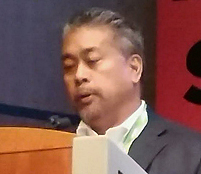29 Sep 2016
Pollution monitoring by remote MIR camera and improved image gathering by new "gimballed" systems, were described.
by Matthew Peach in Edinburgh
Analytical and security applications of photonics-based remote sensing were described by speakers both from commercial and academic backgrounds at this week’s Security + Defence 2016 conference. The focus of one notable session on Monday was passive sensing using various camera technologies and how they can improve detection and analysis of atmospheric conditions.In a presentation entitled Standoff Midwave Infrared Hyperspectral Imaging of Ship Plumes (the exhaust expelled from funnels), Philippe Lageaux from Telops, Quebec, Canada, explained how characterization of such plumes for environmental monitoring purposes is “challenging due to the variety of ships and fuel grades, as well as the highly variable nature of gas plumes”.
To demonstrate the potential of its Hyper Cam system, Telops has been involved in the imaging of ship plumes from a working ferry boat crossing the St Lawrence River in the company’s home of Quebec City. The research was carried out using standoff midwave infrared (3-5µm) hyperspectral imaging.
Passive hyperspectral remote sensing
Quantitative chemical imaging of combustion gases is achieved by using a radiative transfer model. Combustion efficiency maps and mass flow rates are presented for gases including carbon monoxide and carbon dioxide, water and other hydrocarbons that may not have completely combusted. The Hyper Cam system derives temperature maps from the ship plume as well as column density maps of the exhaust gases.
Lageaux said, “The results illustrate how valuable information about the combustion process of a ship engine can be successfully obtained using passive hyperspectral remote sensing and imaging.”He added, “ The collected data in turn lead to the creation of combustion efficiency maps and mass flow rates of the gases. The results illustrate the benefits of standoff midwave infrared hyperspectral imaging as a research tool for the characterization of combustion phenomenon. What and where is no longer enough environmental information: people want to know how much, flow rates and directions.”
Telops’ Hyper-Cam, a 2-in-1 infrared camera is suited to characterizing the exhaust plumes emitted by cargo ships, ferries and similar vessels – both in broadband and hyperspectral ranges.
“High spectral resolution provides selectivity of target or other molecules detected in the plume,” he said. “This gives users information about the chemical nature of each component of the combustion and unburnt gases (due to non-ideal stoichiometry of reaction). Identification of these molecules is carried out by referencing the unique spectral signature of each molecule.”

Telops' Philippe Lageaux.
Expanding hyperspectral imaging
Then Mark Salvador, of Zi Inc., a new business providing applied remote sensing expertise to both commercial and government enterprises, described how his company has been extending the dimensions and capabilities of hyperspectral imagery in order to improve target detection.
He told the S+D audience, “On-going research to improve hyperspectral target detection generally focuses on statistical detector performance, reduction of background or environmental contributions to at-sensor radiance, dimension reduction and many other mathematical or physical techniques."
Salvador added that current approaches are usually limited by refresh and revisit time delays, while Zi’s approach offers speed of delivery advantages: “Emerging gimbaled hyperspectral imagers have the capability to collect multiple scans over the same target location in a timescale of seconds. The ability to scan the same location from slightly different collection geometries below the time scale of significant solar and atmospheric change forces us to reexamine the methods for target detection via the fundamental radiance equation.”

Zi's Mark Salvador.
Research at Zi is re-examining the fundamental radiance equation for multiple scan collection geometries expanding both the spatial and temporal domains. Salvador concluded, “In addition, our assumptions for determining at-sensor radiance are revisited in light of the increased dimensionality. The expanded radiance equation can then be applied to data collected by a gimbaled long wave infrared hyperspectral imager.”
About the Author
Matthew Peach is a contributing editor to optics.org
| © 2026 SPIE Europe |
|